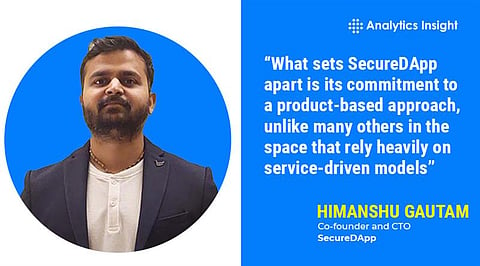“SecureDApp was founded with a clear mission: to create innovative, product-led tools that fortify the Web3 security landscape”, Himanshu Gautam, Co-founder and CTO of SecureDApp
Himanshu Gautam, Co-founder and CTO of SecureDApp, is an IIT Kanpur alumnus with over 8 years of experience in Web3 and blockchain security. Having built and audited multiple decentralized applications and consulted for the Government of India, Himanshu brings deep technical and strategic expertise.
In this exclusive with Analytics Insight, he shares how SecureDApp—endorsed by the Department for Promotion of Industry and Internal Trade—is redefining security in the Web3 landscape and building a safer, more resilient decentralized future.
Web3 security is an evolving battlefield. What inspired you to launch SecureDApp, and how does your vision differentiate from other players in the space?
SecureDApp was born out of a deep understanding of the increasing vulnerabilities in smart contracts that threaten digital assets across decentralized applications (dApps), DeFi platforms, and the broader Web3 ecosystem. Having witnessed these challenges firsthand, we recognized a critical gap in robust, accessible solutions specifically designed to address the unique security issues faced by decentralized platforms. Fueled by a strong passion to empower builders and safeguard users, SecureDApp was founded with a clear mission: to create innovative, product-led tools that fortify the Web3 security landscape.
What sets SecureDApp apart is its commitment to a product-based approach, unlike many others in the space that rely heavily on service-driven models. The platform provides scalable, user-friendly tools tailored to meet a wide range of security needs, proactively addressing vulnerabilities in smart contracts, dApps, and DeFi protocols. SecureDApp places a strong emphasis on accessibility and innovation, ensuring that developers and projects of all sizes can build securely without being dependent solely on custom services. By leveraging cutting-edge technology and automation, SecureDApp delivers efficient, reliable, and future-ready security solutions, making it a standout force in the fast-evolving Web3 ecosystem.
SecureWatch now supports over 20+ chains with real-time threat detection and the unique AutoDefend feature. Could you walk us through how this ML-powered tool works—and what impact it’s had on clients so far?
How SecureWatch Works:
AI-Driven Monitoring: SecureWatch leverages advanced machine learning algorithms to continuously analyze on-chain transactions and smart contract activities across 20+ blockchain networks, identifying patterns indicative of threats like unauthorized access or exploits.
Real-Time Threat Detection: The tool monitors for anomalies, such as unusual transaction behaviors or unauthorized parameter changes, flagging potential security breaches instantly for rapid response.
AutoDefend Feature: This unique feature uses predictive ML models to automatically mitigate threats by triggering predefined countermeasures, such as pausing suspicious transactions or isolating compromised contracts, minimizing damage without manual intervention.
Multi-Chain Compatibility: Seamlessly integrates with diverse blockchain ecosystems, ensuring consistent security policies across networks while adapting to each chain’s unique protocols.
Sharing here the impact on our clients:
Enhanced Protection: Clients across sectors like DeFi, finance, and supply chain report significantly reduced vulnerabilities, with SecureWatch proactively stopping exploits before escalation.
Scalable Security: Support for 20+ chains enables clients to expand their multi-chain operations securely, fostering innovation without compromising safety.
Compliance Support: SecureWatch’s detailed activity logs and threat reports help clients meet regulatory requirements, streamlining audits and ensuring transparency.
With high-profile exploits and losses in Web3 crossing $16 billion globally, what do you think are the most critical vulnerabilities today—and how does SecureDApp proactively stay ahead of such threats?
Web3 faces several critical vulnerabilities that continue to pose significant threats to its security and reliability. One of the most prevalent issues lies in smart contract flaws, where coding errors, such as reentrancy attacks or inadequate access controls, can be exploited by attackers to drain funds or manipulate decentralized protocols. Another major risk involves oracle manipulation, where inaccurate or compromised data feeds can mislead DeFi platforms, leading to financial losses through price distortions or erroneous liquidations.
Additionally, the growing trend of cross-chain interoperability presents its own set of risks, particularly with bridge hacks that exploit weak validation processes or inadequate custody measures. Beyond technical exploits, phishing and social engineering attacks have become increasingly sophisticated, targeting both users and developers to compromise private keys or sensitive project credentials.
Here are some ways SecureDapp stays ahead of threats
Proactive Threat Intelligence: We continuously analyze global exploit trends and on-chain data to anticipate and prioritize emerging vulnerabilities, updating our tools accordingly.
Advanced ML Models: Our AI-driven solutions, like SecureWatch, detect anomalies in real-time across 20+ chains, adapting to new attack patterns without manual intervention.
Automated Mitigation: Features like AutoDefend enable instant responses to threats, such as halting suspicious transactions, minimizing damage before escalation.
Comprehensive Auditing Tools: Our product suite includes pre-deployment and runtime auditing solutions, ensuring smart contracts and dApps are rigorously vetted for weaknesses.
Regulatory compliance and security often operate in silos. How is SecureDApp bridging this gap—especially with products like SecureX-ID score and your work with IFSCA on decentralised fintechs?
Bridging Compliance and Security:
Integrated Approach: SecureDApp unifies compliance and security through products that embed regulatory requirements into robust security frameworks, ensuring seamless alignment for Web3 projects.
Decentralized Compliance Tools: Our solutions, like SecureX-ID, enable decentralized ecosystems to meet KYC/AML standards without compromising the principles of privacy and decentralization.
SecureX-ID: Decentralized KYC/AML Solution:
Functionality: SecureX-ID generates a unique X-ID score for every decentralized wallet address, using proprietary algorithmic research developed internally by SecureDApp.
Anti-Money Laundering Focus: It analyzes transaction patterns and wallet behaviors to identify potential AML risks, enabling DeFi platforms to flag suspicious activities effectively.
Decentralized Design: Built for distributed ecosystems, SecureX-ID ensures compliance without centralized data storage, preserving user privacy and aligning with Web3 ethos.
Collaboration with IFSCA:
Limited Use Authorization (LUA): SecureDApp has secured LUA from IFSCA, GIFT City, enabling us to experiment with digital financial products in a controlled regulatory sandbox.
Security for Fintechs
.png)

